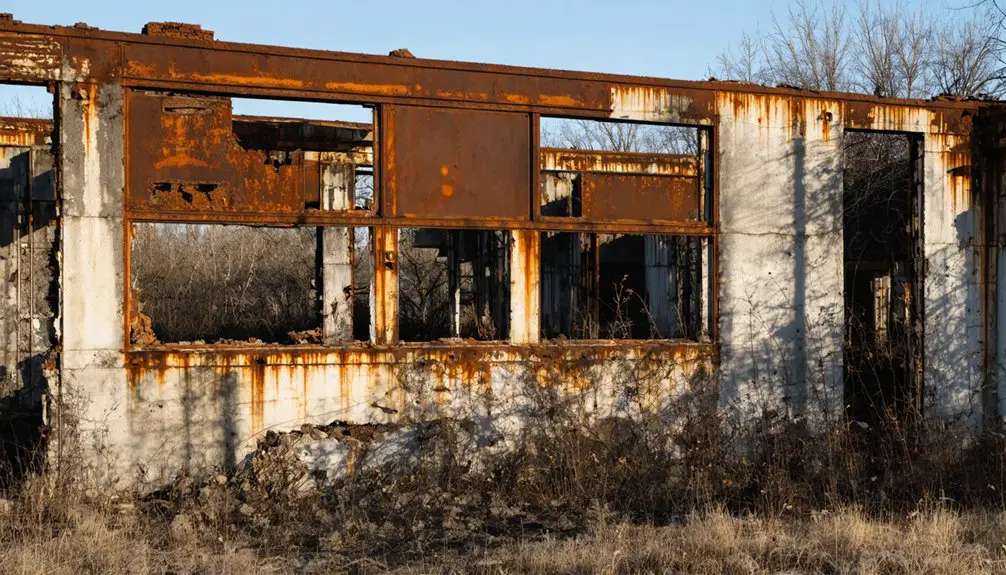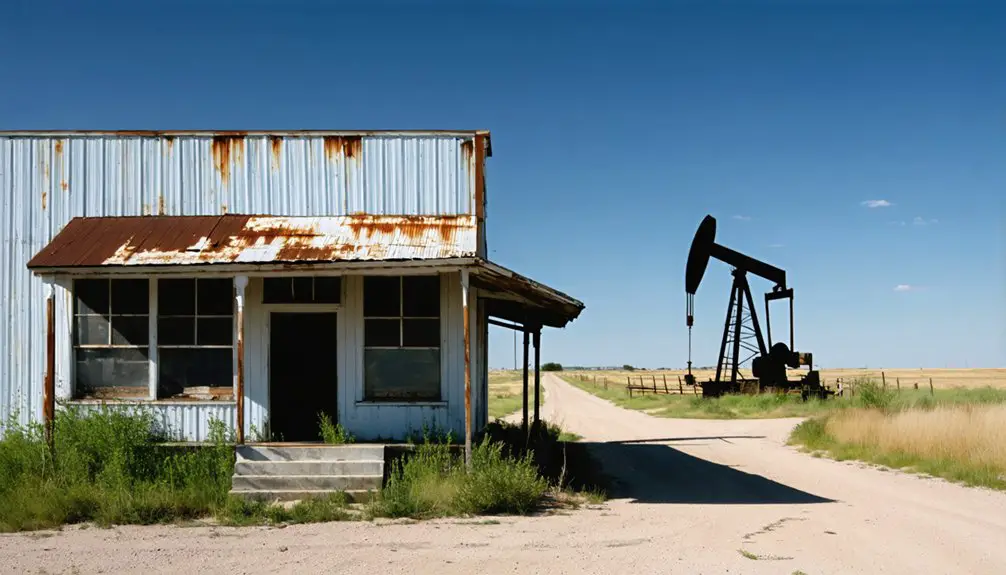You’ll find Zincville nestled in Ottawa County, Oklahoma, where it once bustled with lead and zinc mining activity in the early 1900s. The town’s peak saw 14,000 residents working grueling shifts at St. Louis Smelting & Refining Company, which employed 425 workers during World War I. Today, nature has reclaimed most structures, leaving toxic chat piles and crumbling foundations as silent witnesses to its industrial past. The area’s complex story weaves together boom-town prosperity, environmental impact, and ghostly remnants.
Key Takeaways
- Zincville was a thriving mining community in Ottawa County, Oklahoma that emerged during the early 1900s lead and zinc mining boom.
- The town’s mining operations contributed significantly to America’s zinc and lead production, especially during both World Wars.
- Environmental damage from mining left 70 million tons of toxic chat piles and contaminated water, leading to EPA Superfund site designation.
- Today, Zincville exists as a ghost town with few remaining structures, overgrown vegetation, and crumbling foundations marking its former location.
- Visitors are warned about unstable ground and toxic soil contamination when exploring the abandoned town site.
Mining Town Origins and Early Days
When lead and zinc were first discovered in Ottawa County’s early 1900s landscape, it sparked a mining rush that would transform the region’s destiny.
You’ll find the earliest mining operations took root in the Peoria camp, where companies like Gordon & Wilkins and Chicago Syndicate established their first claims in 1907. The mining techniques were basic but effective – miners extracted silicate ores from red clay and weathered chert, while women and girls hand-sorted the valuable minerals through screening processes. The area’s rapid development led to several place name confusions among the growing mining settlements. The mining industry flourished especially after the largest ore discovery occurred in downtown Picher in 1913.
As claims expanded after 1910, you’d have witnessed the rapid rise of mining communities facing unique community challenges.
Mining companies operated on leased Quapaw lands, following the 1897 ruling that allowed such arrangements. The room-and-pillar method became standard practice, with miners leaving strategic support columns as they tunneled deeper into the earth.
The Rise and Fall of St. Louis Smelting & Refining Co
After several ownership changes in its early years, the St. Louis Smelting and Refining Company found stability when local Collinsville residents purchased it in 1903.
You’ll recognize the operational challenges they faced, as the plant opened in 1904 only to close for three years of construction. Once running in 1907, they’d employ 225 workers, doubling to 425 during World War I’s peak demand.
The company’s community resilience showed in how they adapted, switching from zinc to lead smelting as regional mining trends shifted. The company introduced innovative mechanical rabbler technology that reduced labor requirements from dozens to just two workers per hearth.
They built over 40 structures, including worker housing and a hotel, while creating an artificial pond to cool their blast furnaces. The facility operated on 24 acres east of Pine Lake and north of Pine Lake Road.
Their legacy lives on in Collinsville’s transformed landscape, though not all changes were positive – environmental testing in 2002 revealed concerning lead levels in soil where homes now stand.
Daily Life in a Company Mining Town
If you’d lived in Zincville during its mining heyday, you’d have started your day in one of the company’s modest houses, packed tightly together near the mining operations for efficiency.
You’d have risen early for grueling 10-12 hour shifts in the mines, joining your neighbors as they trudged to work in the pre-dawn hours. The town’s massive mining operations extracted 1.7 million tons of lead that would later supply most of America’s bullets during both World Wars.
Your family would’ve managed daily life in a small company house lacking modern conveniences, where indoor plumbing was rare and space was limited by the standardized construction meant to house as many workers as possible. Children played on chat piles unaware of their toxic nature.
Housing and Living Conditions
Life in Zincville’s company-built housing revealed the stark realities of a mining town’s daily existence.
You’d find yourself in a modest one or two-bedroom frame house, hastily constructed with basic materials and minimal insulation. Your home’s proximity to the mines meant you’d constantly battle toxic dust from chat piles, while the ground beneath your feet could give way without warning. The community reached 14,000 residents during its peak in the 1920s as mining operations flourished.
Heavy trucks and vehicles were forced to take alternate routes to avoid potential street collapses.
As mining operations ceased, you’d watch your neighborhood transform into abandoned homes and crumbling infrastructure.
Your water pipes might fail due to flooded mine shafts, and your children couldn’t safely play outside in the toxic environment. The sidewalks would crack and buckle from subsidence, while sinkholes threatened to swallow entire structures.
Daily life became a constant struggle against environmental hazards, leaving you to face difficult choices about staying or joining the exodus.
Mining Work Daily Routine
The grinding routine of a Zincville miner started well before sunrise, when you’d roll out of your company-built bed to begin your 12-hour shift.
You’d grab your gear, lamp, and lunch pail before trudging to the mine entrance, where supervisors expected punctuality.
Underground, you’d battle darkness, dust, and danger while mastering essential mining techniques – drilling, blasting, and hauling ore through cramped tunnels.
Safety practices were basic: you’d test for toxic gases, check tunnel supports, and rely on fellow miners’ signals to coordinate work.
During brief meals in communal spaces, you’d share stories of close calls and rich ore strikes.
After your shift, you’d emerge exhausted, covered in grime, only to return the next morning – six days straight, with just Sundays for rest or church.
Many miners were unaware that their daily work exposed them to toxic substances that would later cause severe health problems.
The mines were so productive that by 1926, the region became the world’s largest source of lead and zinc.
Environmental Legacy and Toxic Heritage
Mining operations in Zincville left behind a devastating environmental legacy that continues to plague the region today.
You’ll find about 76,800 acre-feet of acidic mine water that’s dissolved surrounding rock, releasing dangerous heavy metals into Tar Creek and the Neosho River. The toxic legacy includes roughly 70 million tons of mine tailings and 36 million tons of mill sand, creating massive chat piles that contaminate both air and soil.
In 1983, the EPA designated the area a Superfund site, but the environmental remediation has proven challenging. The contamination’s severity became clear when 35% of local children tested for dangerous blood lead levels in 1994.
You can still see the impact today in red-stained riverbeds and unstable ground that threatens to collapse into abandoned mine shafts below.
Remaining Structures and Ghost Town Status

Standing as silent sentinels to a bygone era, only a handful of deteriorating houses and an abandoned church remain in what was once the bustling community of Zincville.
You’ll find these remaining structures scattered between Picher and Hockerville, where nature has steadily reclaimed the land. Unlike some ghost towns that preserve their mining heritage through visible ruins, Zincville’s physical evidence has largely vanished.
The town’s transformation into a ghost town mirrors the fate of neighboring communities in the Tri-State Mining District.
You won’t find many traces of infrastructure or town layout anymore – most buildings have collapsed or disappeared entirely.
What’s left serves as a stark reminder of the region’s mining boom and bust, with only these few lonely structures marking where a vibrant community once stood.
Historical Significance in the Tri-State Mining District
You’ll find Zincville’s mining operations were an integral part of the Tri-State Mining District, which produced about half of America’s zinc and 10% of its lead from 1850 to 1950.
The town’s mining activities reflected the broader district’s pattern of small companies leasing and operating mines, with many worker-operators extracting ore from the mineralized lands formerly owned by the Quapaw tribe.
Zincville’s contribution to the district’s massive output proved especially essential during both World Wars, when the region’s zinc and lead production supported the Allied Forces’ military efforts.
Mining Operations Timeline
As commercial mining emerged in the Oklahoma section of the Tri-State District, the Peoria Mining Land Company from New Jersey established the region’s first operations near Peoria in 1891.
Early Zincville mining operations, run by the St. Louis Mining Company, relied on crude methods of hauling ore by wagon to Missouri mills.
You’ll find that mining technology evolved rapidly after 1900, as discoveries near Quapaw, Miami, Picher, and Commerce expanded operations across Ottawa County.
The industry’s growth led to 248 mills operating throughout the district by 1927.
Zincville’s mining activities continued steadily through the early 20th century until 1954, when the St. Louis Mining Company withdrew operations.
After the company’s exit, Zincville quickly transformed into a ghost town, following the boom-and-bust pattern typical of Tri-State District settlements.
Regional Economic Impact
The Tri-State Mining District‘s economic influence stretched far beyond Zincville’s borders, serving as the nation’s principal source of lead and zinc for over 80 years from 1850 to 1970.
You’ll find that the district supplied roughly 50% of America’s zinc and 10% of its lead, with Oklahoma’s Pitcher Field alone contributing 15 million tons.
The region’s economic diversification flourished as mining operations spurred the growth of railroads, processing mills, and supporting businesses.
By 1927, you could count 248 mills throughout the district. Community resilience emerged through job creation for miners, smelter operators, and mill workers, while the mineral leasing system provided royalties to local landowners, including some Quapaw tribe members.
The district’s minerals proved vital during both World Wars, supplying essential materials for munitions and defense industries.
Exploring Zincville’s Modern Landscape

While modern-day Zincville bears little resemblance to its bustling mining heyday, today’s landscape reveals scattered remnants of its industrial past amid overgrown vegetation and deteriorating infrastructure.
If you’re interested in urban exploration, you’ll find a ghost town where nature’s reclaiming what humans left behind. Crumbling foundations and abandoned streets peek through wild growth, while toxic chat piles serve as stark monuments to the area’s mining legacy.
You’ll need to exercise extreme caution if visiting, as unstable ground and contaminated soil make navigation treacherous. There’s no maintained infrastructure or services, and the site’s ecological restoration occurs naturally, without human intervention.
The few remaining structures stand as silent witnesses to a once-thriving community, now reduced to artifacts of Oklahoma’s mining heritage.
Frequently Asked Questions
Is It Legal to Visit and Explore Zincville Today?
You’ll need landowner permission for legal access to Zincville’s remains, and you must follow visitor guidelines regarding toxic hazards and mine dangers in this Tar Creek Superfund area.
What Happened to the Residents After the Town Was Abandoned?
Like scattered leaves in the wind, you’ll find former residents mostly relocated to nearby Ottawa County towns, though some ventured further seeking new opportunities, leaving behind a community legacy still honored today.
Are There Any Underground Mine Tunnels Still Accessible?
You can’t safely access the mine tunnels today – they’re flooded with acidic water, structurally unstable, and legally restricted. Mine exploration attempts would risk deadly collapses and toxic exposure.
How Dangerous Are the Toxic Levels for Short-Term Visitors?
You’re risking serious toxic exposure even during brief visits, with airborne lead dust causing immediate health effects. Don’t let the short duration fool you – visitor safety is severely compromised in this hazardous area.
Has Anyone Attempted to Restore or Preserve Any Zincville Structures?
You won’t find any successful Zincville restoration projects – toxic contamination and government demolition prevented historical preservation efforts. Only fragments remain, with artifacts relocated to Miami’s Dobson Museum for safekeeping.
References
- https://en.wikipedia.org/wiki/List_of_ghost_towns_in_Oklahoma
- http://wikimapia.org/18148940/Zincville-Oklahoma-ghost-town
- https://www.youtube.com/watch?v=FZJc5Ivk2J4
- https://allthatsinteresting.com/ghost-towns/9
- https://en.wikipedia.org/wiki/Zincville
- https://en.wikipedia.org/wiki/Picher
- http://ogs.ou.edu/docs/geologynotes/GN-V73N2.pdf
- https://www.okhistory.org/publications/enc/entry?entry=TR014
- https://www.tandfonline.com/doi/full/10.1080/17445647.2022.2057877
- https://pubs.usgs.gov/pp/0588/report.pdf



